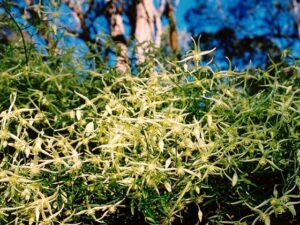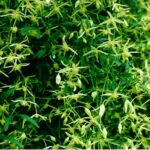Gardening with Indigenous Plants
Indigenous Plant Use
Identification & Control of Common Weeds
| Botanical Name: | Clematis microphylla 2 synonyms: Clematis hexapetala ssp. microphylla, Clematis microphylla var. normalis |
| Common Name: | kenam, small-leaved clematis, tarroke |
| Status: | DISABLED: CATH: It has become weedy so we choose not to stock it. |
| Sold As: | Tube ($2.00) |
| Plant Type(s): | Climber / Scrambler / Creeper, Indigenous Plant Use |
| Indigenous Plant Use: | Taproot can be roasted and eaten.CAUTION: Many plants are poisonous if not collected and prepared properly! |
| Growing Conditions: | Full Sun, Partial Shade
Well Drained |
| Size (HxW): | climbs to 4 m high |
| Foliage: | Similar to Clematis aristata but with small linear leaflets. Light green leaves to 30 mm long, divided into 3's 2-3 times, margins of leaflets entire. Leaflets narrow to egg-shaped. Stalks twining around stems. |
| Flowers: | Masses of starry cream flowers on male and female plants. July-November |
| General Comments: | Female plant has feathery fruit. Medium, dense climber scrambling through the lower and medium storeys. Birds habitat it and use it for nesting. Frost tolerant. A dainty climber for fences and screen areas. Will smother small plants in a garden bed. Foliage tends to be along the top of the creeper |
 Further Information: | |
| Similar Plant(s): | Clematis aristata |
| Plant Propagation: | Propagate from seed or stem cuttings. Sow seeds from springtime, if growing into containers. Seed is collected from early December to early March. Monitor closely as seeds are released 3-14 Separate seed from plumes by rubbing. To clean, Harold Grant suggests first loosening the seed by putting the fruits into a plastic bag and beating it vigorously, then shaking the waste through a coarse then a finer sieve until fluff on the surface can be removed and the seed remains. |




